英语文体学教程
出版时间:2005-3 出版社:高等教育出版社 作者:徐有志 编 页数:321
Tag标签:无
内容概要
《英语文体学教程》 (初版为《现代英语文体学》)本着基础理论与实践并重的原则,简明阐述了当代文体学的理论框架和语言分析方法,具体探讨了语言使用的场合特征与语言特征的相互关系,详细分析了各体英语(包括方言和语域,主要是语域)的语言特点,重点指明了不同体裁文学作品(包括小说、戏剧和诗歌)的文字特色。本书对初步掌握文体学理论概貌和语言描述方法,系统了解各体英语特点,提高恰当运用英语的交际能力,逐步熟悉不同体裁文学作品的语言风格,加深对文学作品的理解和欣赏,无疑将起到一定的作用。本书可供大学英语专业高年级学生使用,也可供攻读硕士学位的研究生和其他英语工作者参考。《英语文体学教程》的编著者徐有志同志是英语语言文学资深教授、博士生导师,长期从事文体学教学与研究,在美进修期间又得到语言学博JsCarolyn Dirksen教授及人类学博J:Murl Dirksen教授的帮助。本书初版手稿曾由河南大学外语系名誉主任、英语语言文学研究所所长、博士生导师,华籍美人ShirleyWood教授审校,经中山大学外国语学院博士生导师王宗炎教授审阅并作序。
书籍目录
1 The Concern of Stylistics 1.1 Stylistics 1.2 Language 1.3 Aspects ofthe Speech Event 1.4 Language Varieties and Function 1.5 Style 1.6 The Study ofStyle 1.7 The Concern of Stylistic Study 1.8 Stylistics and Other Spheres of Study 2 The Need for Stylistic Study 2.1 Stylistic Study Helps Cultivate a Sense of Ap.. propriateness 2.2 Stylistic Study Sharpens the Understanding and Appreciation of Literary Works 2.3 Stylistic Study Helps Achieve Adaptation in Translation 3 Varieties of Language 3.1 Two Kinds ofVarieties 3.2 Dialects 3.3 Registers 3.4 The Mutual Dependence Between Register and Dialect 3.5 The Social Meaning of Language Varieties 4 Linguistic Description 4.l The Aims of Stylistics in Linguistic Descrip-tion 4.2 Levels of Language 4.3 Stylistic Features 4.4 Procedure of Linguistic Description 4.5 The Practical Description and Analysis This Book 5 Formal vs Informal Language 72 5.1 The Interpersonal Function of Language 5.2 Degres of Formality 5.3 Functional Tenor and Degress of Formality 5.4 Matin Joes"Classification 5.5 Speech Situation and Formality 5.6 Formality and Linguistic Features 5.7Sets of Co-occurring Features 5.8 Involved vs Informational Texts 5.9 Tenors, Field ,and Mode 6 Spoken vs Written Language 6.1 Striking Differences 6.2 Stylistic Differences 6.3 Examples of Contrast 6.4 More Delicate Distinctions Amongst Modes of Discourse 6.5 Mode ,Field ,and Tenors7 The English of Conversation 7.1 Necessity of Studying Speech 7.2 Necessity of Sudying Conversation 7.3 Object of Study 7.4 An Adapted Way of Transcription 7.5 A Sample Text of Casual Conversation 7.6 General Features 7.7 Stylistic Features in Terms of Levels of Language 7.8 Summary 7.9 Other Kinds 0t Conversation8 The English of Public Speech 8.1 Scope of Public Speech 8.2 A Sample Text for Analysis 8.3 General Features of Public Speech 8.4 Stylistic Features of Public Speech 9 The English of Advertising 135 9.1 Advertising English as a Variety 9.2 Newspaper Advertising 9.3 Radio Advertising 10 The English of News Reporting 10.1 The English of News Reporting as a Variety 10.2 Two Sample Texts for Analysis 158 10.3 General Features of Newspaper Reporting 10.4 Stylistic Features of Newspaper Reporting 10.5 Stylistic Features of Radio and Television News 11 The English of Science and Technology 180 11.1 The Scope of the English of Science and Tech-nology 11.2 Sample Texts for Analysis 11.3 General Features of EST 11.4 Stylistic Features of EST 11.5 Features of Spoken EST 12 The English of Legal Documents 12.1 The English of Legal Documents as a Variety 12.2 Sample Texts for Analysis 12.3 Stylistic Features of Legal English 13 The English of Literature(I)——General Remarks 218 13.1 Literature as Language Art 219 13.2 Literary Language and Ordinary Language 13.3 Literary English as fl Variety 14 The English of Literature(II)——The Language of Fiction 14.1 Manipulation of Semantic Roles 14.2 Creation of Images and Symbols 14.3 Preference in Diction 14.4 Artistic Manipulation of Sentence Variety and Rhythm 14.5 Employment of Various Points of View 14.6 The Subtle Workings of Authorial Tone 14.7 Various Ways of Presenting Speech and Thought 15 The English of Literature(III)——The Language of Drama 15.1 Manipulation of the Naturalness of Characters"Speech 15.2 Exploitation of Different Speech Act.Turn-taking and Politeness Patterns 15.3 Use of Assumptions,PresuppositiOns and Conversational Implicature 16 The English of Literature(IV)--The Language of Poetry 16.1 Various Devices for Compression 16.2 Extreme Care in Word Choice 16.3 Free Arrangement of Word Order 16.4 Lexical and Syntactical Repetition 16.5 Full Manipulation of Sound Effects 16.6 The Manipulation of Sight 16.7 Analysis of Poems at All Levels Glossary Bibliography
章节摘录
What is stylistics?Simply defined,STYLISTICS is a discipline that studies the ways in which language is used;it is a discipline that studies the styles of language in use.This definition,however,needs elucidation.The stylistics we are discussing here is MODERN STYLISTICS,a discipline that applies concepts and techniques of modern linguistics to the study ofstyles oflanguage use.It has two subdivisions:GENERAL STYLISTICS and LITER ARY STYLISTICS.With the latter concentrating solely on unique features of various literary works,and the former on the general features ofvarious types oflanguage use."Stylistics",in this book,is general stylistics:one that studies the stylistic features of the main varieties of language,covering the functional varieties from the dimension of fields of discourse(different social activities),formal vs informal varieties from the dimension of tenors of discourse differentaddresser-addressee relationships),and the spoken VS wriRen varieties from the dimension of modes of discourse(different mediums).Meanwhile,general stylistics covers the various genres of literature (fiction,drama,poetry)in its study.But it focuses on the interpretationofthe over~~l characteristies of respective genres.With selected extracts of literary texts as samples. PAGE2First,we need to clarify our views on language.We must be clear about what language is,or how we should look at language.There are many definitions of language,or many ways of looking at it.Modern linguistics which began with Saussure"S lectures on general linguistics in 1906-11 regards language as a system of signs.Meanwhile,American structuralism represented by Bloomfield regards language as a unified structure,a collection of habits.From the late 1950s on.the fact that"man talks"and the implications of this human capacity have been at the centre of investigation in the linguistic sciences.The transformational-generative(TG)linguists headed by Noam Chomsky have been concerned with the innate and infinite capacity of the human mind.This approach sees language as a system of innate rules(Chomsky,1957).The approach advocated by the systemic-functional linguists headed by M.A.K.Halliday sees language as a"social semiotic",as an instrument used to perform various functions in social interaction.This approach holds that in many crucial respects,what is more important is not SO much that"man talks"as that"men talk";that is,that language is essentially a social activity(Halliday,1978). PAGE3~
编辑推荐
《英语文体学教程》简短、浅显、理论完整、材料新鲜。
图书封面
图书标签Tags
无
评论、评分、阅读与下载
用户评论 (总计14条)
- 适合英语专业的学生学习.书很好.
- 拿着徐教授的书上徐教授的课,肯定要给好评啦。
- 洗的很系统
- 很好的书,当教材用的,感觉很好
- 课本,内容丰富,质量可以
- 上课用的书,挺好的
- 买来做参考书 不错
- 印刷、纸张都很好
- 文体学经典教材
- 很系统的一本书,清楚明了,自己就可以看懂。英专必备吧~
- 书很好,同学拿到都很喜欢。而且是物美价廉,至于内容嘛~老师上课要用所以才买的
- 老师要求买的 没怎么看过 觉得还行
- 学校文体学课程用的教材,全英文的,还没看,但应该还不错吧
- 还没开始上课,期待ing……
